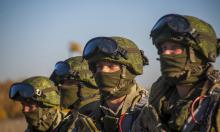China to conquer world arms market with poor quality rip-offs
 US experts believe that China has copied Russian weapons again. This time it goes about submarines. US analysts say that the new Yuan class (type 41 A, B, C) diesel-electric submarines are rips-off of Russian Kilo and Lada projects.
US experts believe that China has copied Russian weapons again. This time it goes about submarines. US analysts say that the new Yuan class (type 41 A, B, C) diesel-electric submarines are rips-off of Russian Kilo and Lada projects.

China purchased several Kilo project submarines from Russia at the end of the 1990s. Back in those years, the subs were considered Russia's most modern non-nuclear submarines as NATO specialists said. Kilo submarines are capable of covering distances of up to 700 kilometers at the speed of 5 km/h in a noiseless mode, without the risk of being detected by enemies. US experts acknowledged that Kilo submarines equipped with SS-N-27 cruise submarines were very dangerous for American aircraft carriers. The cheap price of the deal was the main factor that attracted China: Russia was selling the subs for $200 million each, whereas the cost of Western analogues began from $400 million.
First kilo submarines entered the Soviet navy at the end of the 1980s. Russia built 54 such subs, the Russian navy received 24 Kilo subs, 30 others were exported to China, North Korea and Iran.
Soviet engineers started working on another version of Kilo submarines - 877 Lada - shortly before the collapse of the USSR. The works were suspended in 1997 because of the lack of funding. Russia's first Lada submarine was launched only in 2009. Now Russia is building another Lada submarine and plans to build eight others.
China has built three submarines that bear a striking resemblance to Russian Kilo and Lada subs. It is not really clear how Chinese engineers have managed to rip off the Lada sub, because Russia has not exported any of them yet.
NATO experts consider Lada subs more dangerous claiming that it is much more difficult to detect it because of the sound-absorbing coating and so-called quiet propellers. Lada is eight times less noisy than Kilo submarines; its endurance and operational range is much more considerable.
As for China's underwater fleet, the nation currently has 56 submarines, including three nuclear-powered ones. The increased interest in diesel submarines can be explained with the fact that Chinese nuclear submarines are considered very noisy and therefore are easily detected by US warships.
Have Chinese engineers observed quality? Most likely, they have not. Foreign military experts said that the new Chinese Yuan is larger than Kilo and Lada, but have common design features. A larger size implies larger tonnage, which in its turn negatively changes military qualities.
China previously had the licensed production of Soviet Romeo submarines, which were dubbed in China as "Type 39." Chinese engineers acknowledged that their developments were based on Russian state-of-the-art defense technologies. However, they vehemently denied the fact of blunt copying claiming that that they had considerably improved them.
It is an open secret that China has copied quite a number of Russian weapons. The list begins with Soviet I-15 and I-16 fighter jets, not to mention the legendary Kalashnikov rifle.
The list continues with D-30 howitzer, BMP-1 armored vehicle, BMP-3, Malyutka anti-tank complex, An-12 military cargo plane, Strela-2 shoulder-fired missile complex, S-300 missile system, Msta-S howitzer, Smerch volley-fire system and other weaponry. The last rip-off report was referred to Su-33 deck-based fighter jet.
It may seem strange that Russia has not set forth any claims to China yet. However, China is Russia's long-time partner in the field of arms trade and Russia is not willing to ruin relations with China. Does Russia overestimate the importance of defense cooperation with the Asian giant? China usually makes small one-time purchases that do not bring much profit to Russia. Moreover, the purchases are made to simply copy the original. For example, the Chinese bought one or two radars for fighter jets from Russia only to launch their serial production several years later.
"China is acting like a superpower, whose military power can be noticed both at sea and in the air. To accomplish the goal, China has been copying other weapons, presumably of the Russian origin, to catch up with its primary competitor - the United States. It is not ruled out that China will eventually pursue its goal. Russia did the same during the 1930s and so did the Japanese, who currently top the pedestal of the technological progress. As a result, Chinese submarines will be patrolling US coastlines, like Soviet vessels used to do it," Konstantin Sivkov, vice president of the Academy for Geopolitical Problems told Pravda.Ru.
The fact that China has become very quick in copying Russian arms and launching them in serial production shows that the nation has reached the modern industrial level. The problem is about the quality. Chinese weapons have been reputed in the world as cheap and disposable. However, the Asian giant may eventually solve this problem too some day. In this case, China will easily conquer world markets of arms.
Sergey Balmasov
Pravda.Ru
Subscribe to Pravda.Ru Telegram channel, Facebook, RSS!


